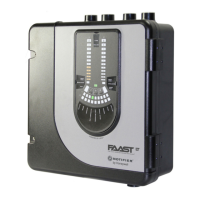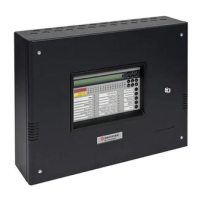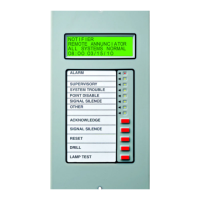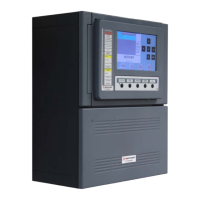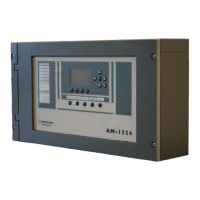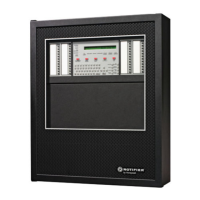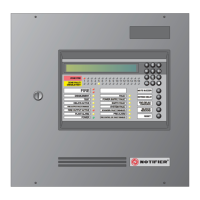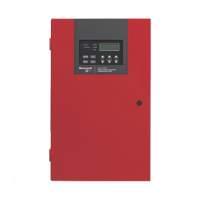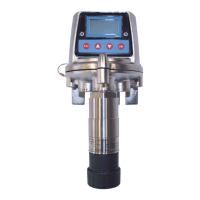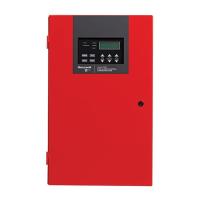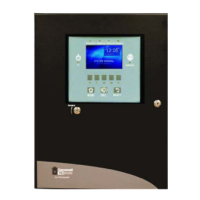
Do you have a question about the Honeywell NOTIFIER FireWarden-100-2 and is the answer not in the manual?
| Model | FireWarden-100-2 |
|---|---|
| Type | Addressable Fire Alarm Control Panel |
| Number of Zones | 2 |
| NAC Circuits | 2 |
| Signaling Line Circuits (SLC) | 1 |
| Operating Voltage | 24V DC |
| Humidity Range | 10% to 93% non-condensing |
| Current Draw - Standby | 170mA |
| Operating Temperature | 0°C to 49°C |
| Compatibility | Compatible with NOTIFIER devices |
Details reasons why smoke detectors might fail to detect fires, including environmental factors and physical barriers.
Explains heat detectors' reliance on temperature changes and potential sensitivity degradation.
Covers limitations of audible/visual alarms, power dependency, and equipment compatibility.
Outlines NFPA 72 requirements for testing after system programming or component changes.
Details operating ranges and safe handling procedures for static-sensitive components.
Lists the main features and optional capabilities of the FireWarden-100-2 control panel.
Provides detailed technical specifications for the FACP, including power, circuits, and components.
Describes the function of the LCD display and the meaning of various system status LEDs.
Details the layout and function of the control panel's keypad, including function and program keys.
Explains the Signaling Line Circuit (SLC) loop for communicating with addressable devices.
Details output circuits like NACs and programmable relays.
Describes the integrated DACT and its communication functions.
Covers the main circuit board, its components, and the system's backbox.
Details transformer, battery requirements, and addressable detectors/modules.
Summarizes the minimal steps to bring the NFW2-100 system online.
Covers telephone line requirements, FCC compliance, and DACT operation warnings.
Provides detailed instructions for mounting the FACP backbox, including hole marking and securing.
Details mounting the main board and transformer assembly into the backbox.
Explains connecting AC power and establishing earth ground for system stability.
Provides instructions for connecting battery backup power, emphasizing polarity and safety.
Details special application DC power outputs, power-limiting, and FCC ferrite bead needs.
Describes FACP relays and the configuration of Notification Appliance Circuits (NACs).
Explains configuring NACs for Style Y (Class B) or Style Z (Class A) using the NACKEY card.
Illustrates wiring connections for four Style Y (Class B) NACs.
Illustrates wiring connections for two Style Z (Class A) NACs.
Details the remote sync output for controlling notification appliance timing.
Explains UL power-limited wiring, circuit separation, and ferrite bead installation.
Illustrates wiring for the digital communicator and two required phone lines.
Provides instructions for installing the 4XTM Transmitter Module for municipal box communication.
Details connecting a serial printer or PC for programming and data output.
Explains ACM-8R module and ACS/AFM annunciator connections.
Describes data entry via keypad or computer keyboard.
Explains programming modes, access, and password entry.
Outlines initial procedures for powering up a new system and programming.
Describes navigation through programming screens and option selection.
Details factory passwords and nonvolatile memory storage for user entries.
Explains entering the Master Programming Level and system behavior upon entry.
Describes Autoprogram for SLC devices and its setup process.
Details Point Program for adding, deleting, or editing detectors and modules.
Provides a step-by-step guide for adding a new detector, including type selection.
Explains the procedure for deleting a specific detector from system programming.
Details changing existing or factory default programming for a detector.
Describes viewing detector summary screens and navigating detector settings.
Explains enabling or disabling a detector, affecting its polling and reporting.
Details selecting detector type from a list of options.
Explains Alarm Verification for smoke detectors to reduce nuisance alarms.
Describes assigning up to five software zones to each addressable detector.
Explains entering custom descriptors for device location identification.
Details entering descriptive information for a device, appearing on the display label.
Provides instructions for adding a new addressable module, including type selection.
Explains the procedure for deleting a specific module from system programming.
Details changing programming for a monitor module.
Describes viewing and editing programming for control modules, including status and zones.
Explains enabling or disabling a module, affecting polling and reporting.
Details selecting monitor module type, affecting operational function.
Configures Pre-signal delay and enables Walktest for monitor modules.
Assigns zones and descriptors to monitor modules.
Explains enabling/disabling control modules and selecting their type.
Configures silenceable operation, walktest, and zone assignments.
Assigns descriptors to control modules.
Provides instructions for enabling or disabling specific zones.
Details configuration of special purpose zones 97 (PAS), 98 (Pre-signal), and 99 (Two Stage).
Describes viewing installed, enabled, and disabled software zones.
Explains programming zone types for Central Station reporting.
Details SLC Loop style wiring and loop communication protocol selection.
Covers Trouble Reminder, Banner, Time-Date, Timers, NACs, and Relays setup.
Explains changing the top display lines (banner) to a user-defined message.
Covers the Trouble Reminder feature for audible alerts on alarms/troubles.
Provides instructions for setting the control panel's time, date, and clock format.
Covers setting date, clock format, and managing daylight savings time.
Details programming delays for PAS, Pre-signal, and Waterflow events.
Explains programming a delay for reporting AC power loss to the central station.
Details configuration options for NACs, including enable/disable and type.
Explains enabling or disabling NACs to control their activation status.
Details selecting NAC device type for programmed output.
Explains configuring NACs for silenceable operation.
Describes Auto Silence and programming the time delay for automatic silencing.
Details available coding options for NAC outputs.
Explains the Two Stage operation sequence for alarms.
Describes assigning software zones to NACs.
Explains enabling Silence Inhibit to prevent NAC silencing.
Details the Verify Loop option for polling SLC devices and checking communication.
Provides instructions for programming FACP relays for various events.
Explains viewing and erasing system events from the history file.
Details performing walktests to verify system device functionality.
Explains enabling and configuring annunciators like ACS and FDU-80.
Describes selecting and programming addresses for ACS annunciators.
Covers enabling onboard DACT and configuring phone line settings.
Details selecting dialing type (Touchtone, Rotary) for the primary phone line.
Details selecting dialing type (Touchtone, Rotary) for the secondary phone line.
Explains setting Panel ID and Ring Count for service terminal connections.
Details entering phone numbers for Terminal 1 and Terminal 2 service connections.
Covers enabling central station reporting and setting the call limit.
Explains configuring backup reporting to secondary or both phone lines.
Details the Trouble Call Limit to prevent excessive DACT trouble calls.
Provides settings for test time interval, account code, and other central station details.
Details setting the test report interval for central station reporting.
Explains entering the account code assigned by the central station.
Details programming the time for the DACT to transmit the 24-hour test.
Explains entering the central station phone number, including valid characters.
Describes selecting the communication format for transmitting data to the central station.
Explains customizing event codes for selected communication formats.
Details accessing Maintenance Programming using the default password.
Explains disabling or enabling individual points (detectors/modules).
Provides procedures for viewing and erasing system events from the history file.
Describes the Program Check feature to identify zones without input/output assignments.
Details performing walktests to verify system device functionality.
Explains programming system time and date via maintenance level.
Provides instructions for enabling, disabling, and configuring special purpose zones.
Explains enabling or disabling specific zones in the system.
Details configuration of special purpose zones 97 (PAS), 98 (Pre-signal), and 99 (Two Stage).
Describes the function of each panel control button.
Details the meaning and operation of the nine LED indicators on the FACP.
Explains the system's normal operating state and its regular monitoring functions.
Describes system indication and response to trouble conditions.
Details system behavior during an alarm, including piezo, LEDs, and communication.
Explains supervisory operation and its system indications.
Describes events initiated by Process Monitor operation.
Details system operation during Hazard or Tornado conditions.
Explains system behavior during a Medical Alert condition.
Provides an overview of NAC operation, including silenceable and coded options.
Describes assigning devices to software zones.
Explains disabling or enabling input and output points.
Details waterflow circuit behavior and interaction with Alarm Silence.
Covers detector monitoring: Maintenance Alert, Auto Test, Type Supervision.
Describes the FACP's real-time clock and daylight savings time.
Explains synchronized NAC operation for controlling notification appliance timing.
Details available coding options for NAC circuits.
Explains Presignal option for delaying alarm activation for verification.
Describes PAS option for smoke detectors to delay panel activation.
Details Silence Inhibit Timer, preventing Alarm Silence key function for 60 seconds.
Explains Autosilence Timer for automatically silencing notification appliances.
Covers Trouble Reminder feature for audible alerts on alarms/troubles.
Details Waterflow Retard Timer, delaying alarm activation.
Explains Alarm Verification for smoke detectors to reduce false alarms.
Details performing walktests to verify system device functionality.
Explains how to enter Read Status mode to view system status.
Details viewing status of detectors and modules by address.
Explains viewing installed, enabled, and disabled software zones.
Describes real-time display of control panel voltages for monitoring power status.
Indicates if the Trouble Reminder feature is On or Off.
Shows configured delay times for PAS, Pre-Signal, Waterflow, and AC Loss.
Details viewing programmed options for NACs.
Explains viewing programmed options for each relay.
Indicates status of program checks for NACs/zones without assignments.
Allows viewing all events stored in the history file.
Shows if annunciator modes are enabled or disabled.
Indicates if phone lines are configured for touchtone dialing.
Indicates central station reporting status and call limit.
Displays Panel ID, Terminal phone numbers, and ring count.
Shows printer/PC configuration and baud rate.
Allows printing of program data, walktest logs, and detector data.
Explains drift compensation for monitoring detector sensitivity.
Details maintenance alerts (INVREP, DIRTY1, DIRTY2) for detectors.
Allows viewing daylight savings time settings.
Lists the priority order for transmitting events to central stations.
Explains downloading the entire program from a Service Terminal.
Details security features like secret code verification and time-outs.
Describes uploading system data to a Service Terminal.
Outlines the four-step process for calculating power supply currents and battery requirements.
Details calculating required AC branch circuit current.
Explains calculating current draws for non-fire, fire, and secondary conditions.
Outlines calculation of system current draw during different conditions.
Provides steps to calculate total standby and alarm load for battery sizing.
Outlines NFPA 72 requirements for standby and alarm power duration.
Guides on selecting batteries and cabinet housing.
Explains device assignment to software zones via programming.
Presents a graphical representation of zone correlations.
Example table for assigning zones, ADJ/NOUN, and addresses to detectors.
Example table for assigning zones, ADJ/NOUN, and addresses to modules.
Lists programming options and their factory default settings.
Details requirements for NFPA 72 Central Station, Auxiliary, and Proprietary systems.
Illustrates the connection diagram for remote station signaling using the 4XTM module.
Provides wire type, limitations, distance, and compatible brands for each circuit.
Explains programming a control module to shut down HVAC fans during fire.
Details using a monitor module to restart HVAC fans.
Describes the HVAC OVRRIDE function to prevent fan shutdown.
